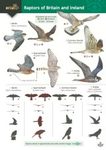Distribution Atlas
Out of Print
By: Tim Dean(Editor), Dick Myatt(Editor), Muriel Cadwallender(Editor), Tom Cadwallender(Editor), Ann Cleeves(Preface By)
512 pages, colour photos, colour distribution maps
![Northumbria Bird Atlas Northumbria Bird Atlas]()
Click to have a closer look
About this book
Related titles
About this book
The Northumbria Bird Atlas is a 512 page, profusely illustrated document which gives the current status of the birds of the area. Between the rivers Tyne and Tweed there are 200 species of birds which commonly breed or spend the winter. The Atlas foreword is by Anne Cleeves, an award-winning crime writer whose novels set in Northumberland about DI Vera Stanhope were transformed into the hugely popular ITV drama series, Vera; she is married to one of the survey team.
Over 10,000 hours of volunteer, unpaid, work were needed for surveys alone. The countryside was divided into over 1400 plots called tetrads and 165 observers walked the land in winter and summer for four years recording every rustle of feather and checking every chirp in the bramble patches to provide the base data. These systematic, scientifically valid surveys were carried out throughout the county from coastal marsh, to the heights of Cheviot, to the allotments of Tyneside between 2007 and 2011 in conjunction with the British Trust for Ornithology national scheme. This field-work was followed by extensive analysis by experts over several years in order to produce this impressive document.
Northumbria Bird Atlas sets a new standard for community records. The superb images of the birds were all taken in Northumberland (with the exception of one species) and provided free of charge by local photographers. Sadly, no one has managed to take an image of the secretive Quail. Every species has an abundance map and a location map giving accurate information.
174 species were recorded as regular winter species and 157 were similarly regular breeding birds. If you want to know if Yellowhammers breed in Netherwitton or Nuthatches are found in Newbiggin Northumbria Bird Atlas is the book for you. Current abundance and location of species is shown on detailed maps, all indicated by easily read symbols. Changes in species abundance and range are detailed since the last Northumbrian Bird Atlas was published some 25 years ago. For example, the once common Grey Partridge has become hard to find and the Corn Bunting is now all but extinct in our county, however other species have become frequent visitors to our gardens. For instance the Goldfinch can be seen in many a suburban garden and on the river Tyne that elegant sea-bird the Kittiwake has expanded its breeding range inland to the iconic Tyne Bridge.
Customer Reviews
Distribution Atlas
Out of Print
By: Tim Dean(Editor), Dick Myatt(Editor), Muriel Cadwallender(Editor), Tom Cadwallender(Editor), Ann Cleeves(Preface By)
512 pages, colour photos, colour distribution maps






































